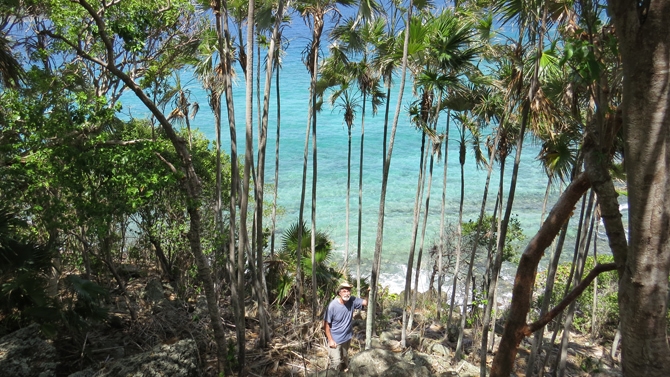Collecting Palms in the US Virgin Islands
 Larry Noblick recently returned from a palm collecting expedition in the US Virgin Islands. The islands are mostly composed of sedimentary and metamorphic rocks uplifted from the ocean floor due to the movement of molten magma under the sea floor. Located just east of Puerto Rico are St. Croix, St. Thomas and St. John. Larry visited St. Croix and spent a day on St. Thomas. Even though St. Croix and St. Thomas are less than 40 miles apart, the shoreline drops off rapidly into a cavernous trench over 5,000 feet deep between them; St. Thomas is riding on the North American plate, whereas St. Croix is riding on the Caribbean plate, which explains the deep trough between them.
Larry Noblick recently returned from a palm collecting expedition in the US Virgin Islands. The islands are mostly composed of sedimentary and metamorphic rocks uplifted from the ocean floor due to the movement of molten magma under the sea floor. Located just east of Puerto Rico are St. Croix, St. Thomas and St. John. Larry visited St. Croix and spent a day on St. Thomas. Even though St. Croix and St. Thomas are less than 40 miles apart, the shoreline drops off rapidly into a cavernous trench over 5,000 feet deep between them; St. Thomas is riding on the North American plate, whereas St. Croix is riding on the Caribbean plate, which explains the deep trough between them.
The islands have been under a severe drought since late 2014, resulting in the death of many plants, including coconut palms. St. Croix received only two inches of rain from January to late August, when Tropical Storm Erika dropped a much needed one and a half to two inches, causing the island to recently green up. However, the drought threw off normal flowering and fruiting cycles, making palm seed hunting difficult. But diligent searching on hands and knees in some of the dry stream gullys (locally called guts) recovered seeds from the Puerto Rican Royal Palm (Roystonea borinquena). Elsewhere on the island there was no hint of fruiting, but Larry was able to take some great photos, herbarium specimens, and notes, and made friends on both islands who offered to send seed. Of particular interest is the native thatch palm, Coccothrinax alta, pictured here.

